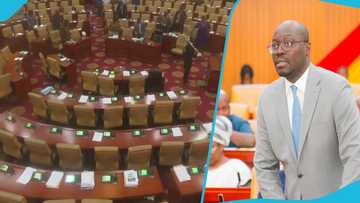GSS Projects Ghana's Population To Hit 58.77 Million By 2050, Accra's Population Density To Deepen
- The Ghana Statistical Service has released its population projections for the country from 2021 to 2025
- The Statistical Service projects that the country's population would surpass 50 million by 2050
- Accra's population density is also expected to deepen by 2030 reaching 2,143 persons per square kilometre
The Ghana Statistical Service (GSS) has projected that Ghana’s population will hit 37.23 million in 2030 and 58.77 million in 2050.
This represents a 70.36 per cent increase by 2050.

Source: Getty Images
The report, ‘Population Projections 2021-2050,’ was launched in Accra on Tuesday, July 2, 2024.
It utilises data from the 2021 population and housing census as well as historical sources to reach its projections.
It also factored in migration, fertility and mortality rates.
The report suggests that 72,000 people are expected to be added to the country’s population each year from 2021 to 2025.
It also noted that the country's child population would proportionally reduce to 29.1 per cent, and that of persons above 60 would increase to 10.8 per cent by 2050.
In the 2021 population census, Ghana’s population was 30.83 million. It is projected that the population will increase by 1.07 per cent in 2024.
Dr Faustina Frempong-Ainguah, the Deputy Government Statistician in charge of Social and Population Statistics, said the projections would help the government track the implementation of developmental goals in the country.
Regional breakdown of the population growth
Accra’s population density is expected to deepen by 2030, reaching 2,143 persons per square kilometre.
Both the populations of the Greater Accra and Ashanti Regions are expected to surpass 7.5 million by 2050.
On the other hand, nine out of the 16 regions will continue to remain rural by 2030.
These regions include the Volta, Oti, Upper East and West Regions and Savannah Regions.
Dr Frempong-Ainguah suggested that to lighten the population pressure on urban areas such as Accra and Kumasi, developmental projects and jobs should be moved to the less populated areas to attract the booming urban population to those areas.
She also urged a change in Ghana’s building habits.
She advised that to make the most of land in the capital city, more property developers should build high-rises to accommodate the population explosion expected by 2050.
Dr Frempong-Ainguah further urged the government to begin making provisions for the elderly as their population grows.
9,000 people multidimensionally poor
YEN.com.gh reported that a newly released GSS survey report reveals that the Ashanti Region has the highest count of multidimensionally poor people.
It is followed closely by the Northern Region, which has a multidimensional poverty count of about 800,000 individuals.
The GSS states this reflects a nationwide issue of widespread poverty and deprivation.
Proofread by Berlinda Entsie, journalist and copy editor at YEN.com.gh
New feature: Сheck out news that is picked for YOU ➡️ click on “Recommended for you” and enjoy!
Source: YEN.com.gh



